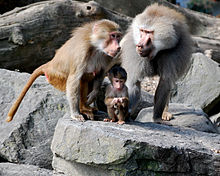Baboons
genus of mammals
(Redirected from Baboon)
Baboons are African and Arabian Old World monkeys belonging to the genus Papio, part of the subfamily Cercopithecinae. The five species are some of the largest non-hominoid members of the primate order; only the mandrill and the drill are larger.


Quotes
edit- There once was a brainy baboon,
Who always breathed down a bassoon,
For he said, "It appears
That in billions of years
I shall certainly hit on a tune".- Arthur Stanley Eddington, New Pathways in Science (1939).
- Evolution is a process that never stops. Baboons who fail to exhibit moral behavior do not survive; they wind up as meat for leopards.
- Robert A. Heinlein, Expanded Universe, (1980), "The Pragmatics of Patriotism," (1973), address to the U.S. Naval Academy.
- When I first began working with baboons, my main problem was learning to keep up with them while remaining alert to poisonous snakes, irascible buffalo, aggressive bees, and leg-breaking pig holes. Fortunately, these challenges eased over time, mainly because I was traveling in the company of expert guides—baboons who could spot a predator a mile away and seemed to possess a sixth sense for the proximity of snakes. Abandoning myself to their far superior knowledge, I moved as a humble disciple, learning from masters about being an African anthropoid. Thus I became (or, rather, regained my ancestral right to be) an animal, moving instinctively through a world that felt (because it was) like my ancient home.
- Barbara Smuts, Reflections, in The Lives of Animals (Princeton University Press, 1999), p. 109.
- There were 140 baboons in the troop, and I came to know every one as a highly distinctive individual. Each one had a particular gait, which allowed me to know who was who, even from great distances when I couldn't see anyone's face. Every baboon had a characteristic voice and unique things to say with it; each had a face like no other, favorite foods, favorite friends, favorite bad habits.
- Barbara Smuts, Reflections, in The Lives of Animals (Princeton University Press, 1999), p. 111.
- The strain of man's bred out
Into baboons and monkey.